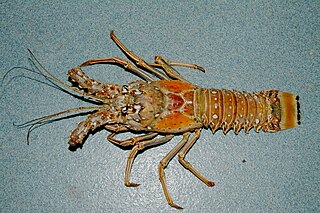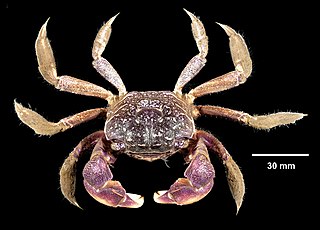
Pillar coral is a hard coral found in the western Atlantic Ocean and the Caribbean Sea. It is the only species in the monotypic genus Dendrogyra. It is a digitate coral -that is, it resembles fingers or a cluster of cigars, growing up from the sea floor without any secondary branching. It is large and can grow on both flat and sloping surfaces at depths down to 20 m (65 ft). It is one of the few types of hard coral in which the polyps can commonly be seen feeding during the day.

Stenorhynchus seticornis, the yellowline arrow crab or simply arrow crab, is a species of marine crab.

The Jonah crab is a marine brachyuran crab that inhabits waters along the east coast of North America from Newfoundland to Florida. Jonah crabs possess a rounded, rough-edged carapace with small light spots, and robust claws with dark brown-black tips. The maximum reported carapace width for males is 8.7 in (222 mm), while females rarely exceed 5.9 in (150 mm). It is the closest relative to the European brown crab in the Western Atlantic.

Alcyonacea are an order of sessile colonial cnidarians that are found throughout the oceans of the world, especially in the deep sea, polar waters, tropics and subtropics. Whilst not in a strict taxonomic sense, Alcyonacea are commonly known as soft corals. The term "soft coral" generally applies to organisms in the two orders Pennatulacea and Alcyonacea with their polyps embedded within a fleshy mass of coenenchymal tissue. Consequently, the term "gorgonian coral" is commonly handed to multiple species in the order Alcyonacea that produce a mineralized skeletal axis composed of calcite and the proteinaceous material gorgonin only and corresponds to only one of several families within the formally accepted taxon Gorgoniidae (Scleractinia). These can be found in order Malacalcyonacea (taxonomic synonyms of include : Alcyoniina, Holaxonia, Protoalcyonaria, Scleraxonia, and Stolonifera. They are sessile colonial cnidarians that are found throughout the oceans of the world, especially in the deep sea, polar waters, tropics and subtropics. Common names for subsets of this order are sea fans and sea whips; others are similar to the sea pens of related order Pennatulacea. Individual tiny polyps form colonies that are normally erect, flattened, branching, and reminiscent of a fan. Others may be whiplike, bushy, or even encrusting. A colony can be several feet high and across, but only a few inches thick. They may be brightly coloured, often purple, red, or yellow. Photosynthetic gorgonians can be successfully kept in captive aquaria.

Panulirus argus, the Caribbean spiny lobster, is a species of spiny lobster that lives on reefs and in mangrove swamps in the western Atlantic Ocean.

Sesarma reticulatum, the purple marsh crab or simply marsh crab, is a crab species native to the salt marshes of the eastern United States.

Mithraculus sculptus, the green clinging crab or emerald crab, is a species of crab in the family Majidae. It is a dark green colour and is found in tropical waters in the Caribbean Sea. It is sometimes kept in reef aquaria.

The hawksbill sea turtle is a critically endangered sea turtle belonging to the family Cheloniidae. It is the only extant species in the genus Eretmochelys. The species has a global distribution that is largely limited to tropical and subtropical marine and estuary ecosystems.

Percnon gibbesi is a species of crab. It is one of at least two species commonly called Sally Lightfoot, and is also referred to as the nimble spray crab or urchin crab. It has been described as "the most invasive decapod species to enter the Mediterranean".

Paromola cuvieri is a species of crab in the family Homolidae, the carrier crabs. It occurs in the eastern Atlantic Ocean and the Mediterranean Sea, from Angola to Norway, the Northern Isles and Iceland. It is demersal, occurring at depths of 10–1,212 metres (33–3,976 ft), but it is primarily found deeper than 80 m (260 ft). It prefers areas with mud and emerging rocks, and has been observed in deep-water coral gardens and sponge aggregations. It is locally common.

Guinotellus melvillensis is a species of crabs in the family Xanthidae, the only species in the genus Guinotellus. It is a benthic crab with an ovate carapace within the subfamily Euxanthinae.

Libinia dubia, the longnose spider crab, is a species of crab in the family Epialtidae. It is found in shallow waters on the eastern coast of North America.
Libinia ferreirae is a species of tropical spider crab in the family Epialtidae. It is found on the seabed in shallow waters off the Atlantic coast of South America.
Mithraculus cinctimanus is a species of crab in the family Majidae. It is found in the Caribbean region and is usually associated with a sea anemone, sponge or coral.
Cymo melanodactylus, the furry coral crab, is a species of small decapod crustacean in the family Xanthidae. It is found in the Indo-Pacific Ocean and lives in crevices and on the surface of corals in the genus Acropora.

Dyspanopeus texanus is a species of crab known as the Texas mud crab.

Portunus sayi, the sargassum swimming crab, is a species of pelagic crab in the family Portunidae. It is found in the western Atlantic Ocean and the Caribbean Sea where it makes its home among floating mats of Sargassum seaweed. It was named in honour of the American naturalist Thomas Say.

Antillogorgia bipinnata, the bipinnate sea plume, is a species of colonial soft coral, a sea fan in the family Gorgoniidae. It is found in the Caribbean Sea. It was first described as Pseudopterogorgia bipinnata in 1864 by the American zoologist Addison Emery Verrill. Williams and Chen (2012), transferred all the Atlantic species of Pseudopterogorgia to Antillogorgia.

Eurypanopeus depressus, the flatback mud crab or depressed mud crab, is a true crab belonging to the infraorder Brachyura and the family Panopeidae. It is native to the western Atlantic Ocean and is often found in estuaries and lagoons, commonly living in close association with oysters.

Paguristes puncticeps is a hermit crab, in the family Diogenidae. It is found in shallow waters in the tropical western Atlantic Ocean, the Caribbean Sea and the Gulf of Mexico. Like other hermit crabs, it lives inside an empty mollusc shell, which it changes periodically as it grows.


















